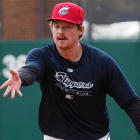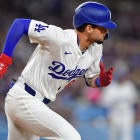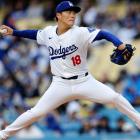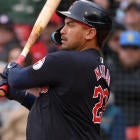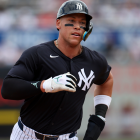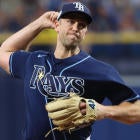We're in the calm before the storm for baseball. All of the big-name prospects have gotten their calls to the majors, and the trade rumors won't really start flying for a few more weeks. We've got the All-Star break coming up soon, and then things really start to get wild.
For Fantasy owners, however, June is as important as any other time of the year. In fact, a well-timed run or poorly timed slump at this point in the season might make the difference between selling or buying at the trade deadline, so you can't just sit on your hands.
Looking at the best and worst pitchers in the league in the month of June, there are some names that stand out in both good and bad ways. Should Fantasy owners be buying into these performances as we head into the heart of the season?
The Good
Yovani Gallardo, Rangers
0.54 ERA in 33 1/3 IP; 1st out of 111 pitchers
There was a time when Gallardo was considered one of the best pitchers in baseball. No, really! He had a decent bounceback campaign in 2014, and appears to be building on what brought him that success. He still isn't striking people out (6.6 K/9), but he has developed into a solid groundball pitcher with above-average control to go with it. His Fantasy upside is limited by his contact-heavy ways, and he is pitching way over his head right now, but Gallardo's 3.47 FIP shows that he can still be an above average pitcher. There is value there.
Jaime Garcia, Cardinals
1.03 ERA in 35 IP; 2nd out of 111 pitchers
All of those things I said about Gallardo? They apply to Garcia even more. He won't post strong strikeout numbers, but he does absolutely everything else you want a pitcher to do well. He rarely issues free passes (4.0 BB percentage since start of 2014), racks up huge numbers of groundballs (61.4 percent last two seasons) and induces a bunch of weak contact (27.5 percent hard-hit rate in 2015). He is a constant injury concern, but there is no questioning what he can do when he is healthy. He has a 3.02 FIP and 2.96 xFIP for the season, and should be a good contributor in ERA and WHIP, even if the strikeouts are limited a bit.
Tommy Milone, Twins
2.03 ERA in 31 IP; 9th out of 111 pitchers
Everything that makes the success of Gallardo and Garcia seem sustainable in spite of their poor strikeout rates does not apply to Millone. He strikes out even fewer batters than the two players above him, while sporting worse control and a fly ball-heavy approach that will eventually prove costly. He has already given up eight home runs for the season in 53 2/3 innings, but has an 83.0 percent strand rate to make things look better than they are. As a two-start streaming option against a couple of good matchups, Millone has some value. Beyond that, he is looking at exactly the kind of regression to the mean that saw teammate Mike Pelfrey's ERA jump from 2.28 to 3.81 in the span of four starts.
Kendall Graveman, Athletics
2.08 ERA in 42 IP; 6th out of 111 pitchers
Gravemen is the only player among this list for whom "June" isn't just an arbitrary endpoint; he only got recalled from the minors two starts before June began. Even if we expand the sample size to include his two May outings, Graveman's ERA only expands to 2.01. He doesn't have huge peripherals, though he has improved on both his K and BB rates since his false start to open the season. Still, for the season, his FIP is a full run higher than his ERA, a good sign that regression is coming and it's going to hit hard. He is a lot like Milone in that way.
Mike Montgomery, Mariners
2.04ERA in 35 1/3 IP; 10th out of 111 pitchers
What to make of Montgomery? He is a former top prospect who arrived in the majors to little fanfare, posted pedestrian strikeout numbers, and then fanned 10 Royals in a complete-game victory in his most-recent start. That start would have been impressive enough in a vacuum, let alone when it comes against the least strikeout-prone team in baseball. Overall, his strikeout rate fails to impress much at all, but last week's start is a sign that his upside is higher than his overall record shows. The question is, how will he follow it up? Montgomery is now 66 percent owned in CBSSports.com leagues, but there's no way that number stays static; after his last start, it is either going to jump up again if he has another good start or tumble back to Earth if he fails to live up to it. For now, skepticism is the way to go.
The Bad
6.55 ERA in 33 IP; 108th out of 111 pitchers
On June 2, Cashner and Noah Syndergaard both struck out 10-plus batters in fewer than five innings of work, while giving up 10-plus runs and five-plus hits. At the time, I said it was probably a sign of good things to come -- being able to strike out that many batters is generally a good thing -- and that has held true for Syndergaard, who has a 3.38 ERA with 21 strikeouts in 24 innings in four starts since. Cashner has kind of gone the other way, bottoming out to the tune of a 6.04 ERA in his last five outings. He has just three more strikeouts (17) than walks (14) in that time, but Cashner is still throwing plenty hard since that start -- 95.9 MPH with his fastball -- so I don't know what the answer is here. It could just be a blip on the radar, but you have to be at least a little concerned about how much he has struggled over his last five starts. You probably just have to ride it out and hope he turns things around at this point.
Trevor Bauer, Indians
6.26 ERA in 27 1/3 IP; 105th out of 111 pitchers
"If Bauer can just get his control problems under control …" For a little while, it seemed like he had; he had a 2.97 ERA through the end of May, with a 9.6 percent walk rate. That walk rate has jumped to 13.7 percent in his last five starts, and his fly-ball tendencies have come back to bite him with five homers as well. The upside Bauer showed in his first 10 starts makes him worth waiting on, but you absolutely cannot count on him as a starter right now.
Jeff Samardzija, White Sox
5.75 ERA in 40 2/3 IP; 100th out of 111 pitchers
We've been waiting for Samardzija to turn things around all season, and June hasn't really changed that. His peripherals for the month are nearly identical to what he has posted for the season as a whole, and they aren't terribly impressive; a 3.91 FIP isn't exactly lighting the world on fire. Samardzija has been very good at times in his career, including last season, but has been marked more by his inconsistency than anything else. You have to hold on to him -- and maybe hope the White Sox trade him -- but it's hard to expect No. 2 SP upside at this point.
Jon Lester, Cubs
5.74 ERA in 26 2/3 IP; 99th out of 111 pitchers
When it was just a bad April, Lester's owners could shrug it off, especially when he followed it up with an utterly dominant May run. Now, however, he has been flat-out bad for two out of three months, which makes it awfully hard to just write off, right? No, of course not! Lester's overall FIP is still 3.57, as he continues to record nearly a strikeout per inning, with a solid walk rate and decent groundball tendencies. He may never be as good as he was a year ago, but he is a much better pitcher than he has shown for much of this season. If his owner is panicking, now is the perfect time to swoop in with a lowball offer.
Michael Pineda, Yankees
5.72 ERA in 28 1/3 IP; 98th out of 111 pitchers
If you've been following this blog, you know I'm a big believer in Pineda. There have been bumps in the road, yes, and June definitely qualifies. On the other hand, his FIP and xFIP are both below 3.30, so it's not like the skill set that made him so promising hasn't just disappeared. Pineda is still throwing his changeup more often than ever, and it has given him a second weapon along with his wipeout slider. He isn't an ace, but I like Pineda as a solid No. 2 Fantasy starter from this point on; if his owner doesn't value him as such, make a lowball offer. I am not concerned at all about this June swoon.













